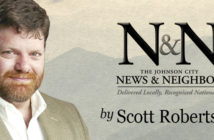By Jeff Keeling
Pale blue chicory flowers and white Queen Anne’s Lace speckled the foreground early Saturday morning as I pedaled northeast on Watauga Road. Behind them, three small airplanes broke above the tall grass, gleaming white and ready to briefly free their owners from nature’s bonds.
And what sights those riders would see on a blue sky morning with the air quickly warming. For behind them spread a feast for the eyes – the spine of Holston Mountain jutting its way into the horizon, its steep coves’ sharp outlines muted by the trees’ deep green and the air’s slight haze.
Behind Holston Mountain, visible from the air but not to me, ridges and valleys marched northeast, cut by creeks and by the rivers that attracted European settlers to venture here from the Eastern Seaboard starting in the mid-1700s. By edict of King George III, European settlement had been forbidden, but the Royal Proclamation of 1763 had been no deterrent to settlers lured by the rich valleys of the Holston, Watauga and Nolichucky rivers.
As I gained momentum in a gentle descent toward the Watauga, the chicory blossoms began to blur in my peripheral vision. I was headed toward an entrepreneurial nerve center of those early days, the Dungan St. John Mill. With day trippers who arrived by bus, I would soon step inside the finely crafted stone house that Jeremiah Dungan built sometime around 1777, not far from a grain mill he constructed to take advantage of the settlers’ needs for a good mill.
A master stone mason originally from Pennsylvania, Dungan moved to the site from Chilhowie, Va., and got a jump on the competition. Ron Dawson, whose wife Betty St. John Dawson is eighth in a line of owners-operators, told me of the mill’s role in helping the Overmountain Men who mustered at Sycamore Shoals before marching to aid the Americans’ victory in the 1780 Battle of Kings Mountain.
Dungan provided the men with parched corn, Dawson said, with the parching accomplished mainly due to the speed with which the millworks were moving to aid the cause. The Dawsons shared a bushel of interesting stories with their visitors Saturday, which is no surprise considering the business operated through parts of four centuries, continually adapting to change, before finally closing several years ago.
Adaptability has long marked our region. In many ways, it’s been difficult to prosper here. For a couple of centuries, this region’s rugged terrain was a bane to effective transportation, and thus to growth and development. It also left the landscape relatively unspoiled, and allowed for the rise of a distinct culture with charms of its own.
Even now, we face the need to adapt if we don’t want the area to enter a phase of slow decline. We need another wave of settlers like those who formed the Watauga Association in 1772. Though we have yet to fully capitalize, there’s a new highway out there, and this area’s beautiful mountains, ridges and valleys aren’t really an impediment any more.
This highway means many well-educated, high-earning individuals and families can write their own ticket. Given sufficient download and upload speeds, they can as easily set up shop up a quaint holler 15 minutes from downtown Johnson City as they can in a regentrified row of brownstones in Brooklyn.
Take the patent attorney and his wife, who felt just a little stifled, just a tad squeezed, perhaps, there on the fast track to “having it all” in the Washington D.C. megalopolis. Her family was enjoying life down here in good ol’ Northeast Tennessee, and boy was it nice to come visit.
Mr. Attorney wangled his way to the opportunity to conduct his relatively lucrative occupation at his choice of location. Well, wouldn’t you know it, they didn’t just have great music, fantastic fishing and hiking and a tolerable array of dining options and cultural diversity down in the Tennessee hills – they had good Internet.
That couple (it’s a true story) lives in our metro now. They’re early adopters. By my reckoning, there are hundreds if not thousands more like them out there, spinning the lousy commute, expensive housing hamster wheel simply because they don’t yet know their ideal future lies in the Tri-Cities.
We need to continue working to attract mid- and large-scale employers to this region. But we also need to figure out what it takes to get on the radar screen of these folks who can ply their well-paid trades anywhere, thanks to 21st century technology. I believe we’ll find the money of a couple of hundred families with average incomes of $150,000 who earn their living at the home office benefits our economy just as much as 200 new mid-level management jobs. Their contributions to the community and our overall educational attainment won’t be anything to sneeze at, either.
We’ve got the natural, historic, arts and cultural assets to attract those families and singles. Popular culture-wise, we occupy a nice little outdoorsy, hillbilly hipster niche. Private-public partnerships and the public sector have slowly been building our inventory of the kinds of amenities – parks, trails, aquatic centers, museums – this target audience expects to find wherever they live.
All we need to do now is keep developing those amenities, keep being our musical, friendly, rural/urban selves, refrain from paving over paradise, and market the Jewel of the Mountain South to all these folks who want to live here and just don’t know it yet. I believe the rest will take care of itself, much to our benefit and that of our future neighbors and friends.




